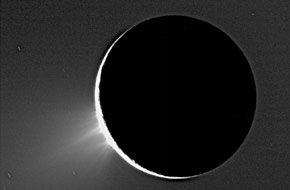The most surprising astronomical news from the American Geophysical Union's (AGU) December confab in San Francisco involved small worlds of ice.

The Cassini spacecraft looked back toward Saturn's icy moon Enceladus and caught its profile backlit by sunlight revealing several geyser-like plumes towering above the 500-kilometer-wide satellite.
Enceladus's water plumes remain a great mystery. The 300-mile-wide (500-km) moon's rocky core is larger than those of Saturn's similar icy satellites, but still too small to generate much radioactive heat. Nor is there enough Europa-like tidal energy to melt ice — probably even if mixed with ammonia, which reduces its melt temperature.
And yet, to paraphrase Galileo's apocrypha, the geysers exist!
John F. Cooper (NASA/Goddard Space Flight Center) and his collaborators reported on a possible "Old Faithful" mechanism. This idea might also explain the geysers on Neptune's moon Triton and suspected activity on bright Kuiper Belt objects.
In their scenario, electrons in the planet's magnetosphere and cosmic rays oxidize surface water ice, which cause highly reactive oxidants to accumulate very slowly. These are buried by impact "gardening" and falling snow from the plumes.
A rare large impact or a period of exceptionally strong gravitational heating, in the possible presence of metallic catalysts from meteorites or the rocky core, could cause the accumulated oxidants to react with primordial ammonia, methane, and other hydrocarbons buried in the ice. This could melt ammonia-contaminated water ice, generating gas and pressure to drive episodic volcanism.
How about "volcanism" on a body just 6 km in diameter? H. Jay Melosh (University of Arizona) said Comet 9P/Tempel 1 features pits next to striated glacier-like deposits extending up to 3 km downhill. The deposits have volumes similar to the pits.
Melosh notes that even distant comets have periodic "outbursts" of gas on average once every 10 years. Gas flowing quickly through granular material to the surface vacuum may form a bubble that bursts onto the surface. The excavated material flows until the gas pressure is lost, leaving a steep scarp at the end of the flow.
At the other extreme of the cold-world size range, Alexander G. Hayes, a graduate student at Caltech, found that the dry lake beds on Titan, located at low and high latitudes, can be several hundred meters deep. The north polar liquid-methane seas are found at the lowest elevations and all at the same level, suggesting that they're part of a common aquifer. Smaller lakes inhabit several different levels some 700 meters higher than the seas.
The asymmetric distribution of Titan's lakes, with more at the north pole than the south, may be caused by the shorter, colder summers currently experienced by the south pole. Saturn's orbital eccentricity changes over tens of thousands of years, so Titan's seas may migrate from pole to pole on that schedule.
Donald F. Robertson is a freelance space-industry journalist based in San Francisco.
 0
0
Comments
You must be logged in to post a comment.